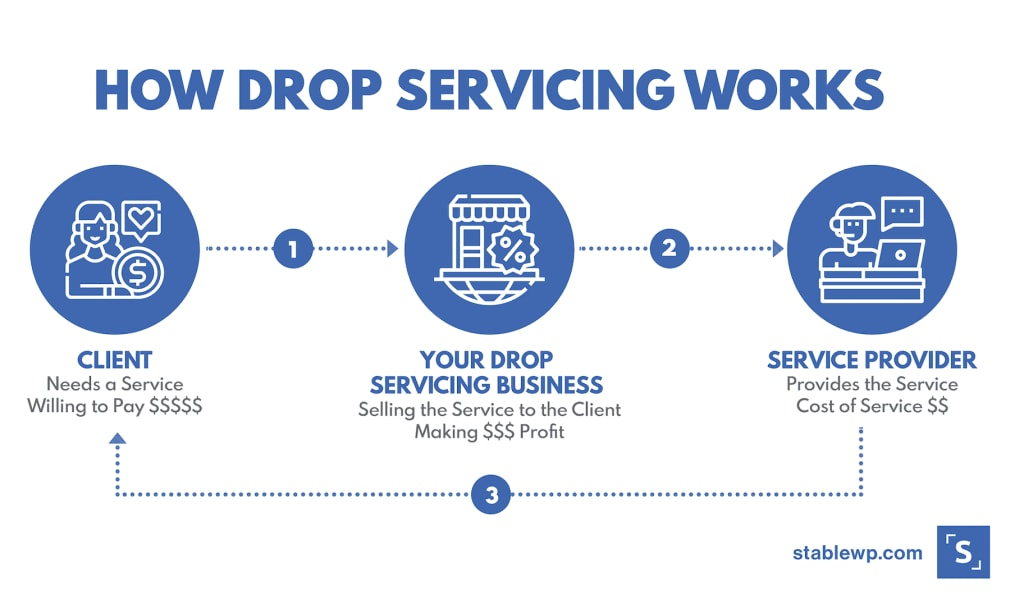In this article:
- What is drop servicing?
- Three Reasons to Start a Drop Servicing Business
- Pros and cons of drop-servicing
- How to start drop servicing
- Final Thoughts
- Drop Servicing FAQs
With the rise of AI, the oversaturation of the social media market, and the increase in layoffs, drop servicing is the new business frontier.
First, let’s look at what this digital service is.

What is drop servicing?
Throughout history, companies have found customers and paid employees to provide services to the customers. Imagine that in a digital age.
Money Note: If an extra $1K–$5K/month would change your 2026 goals (debt, savings, travel, freedom), you’ll want to catch this: free live workshop from a freelancer who’s earned $4M+ online. No fluff. No gimmicks. A real roadmap. 👉 Watch the training or save your seat here »
Drop-servicing is finding a job online, hiring a freelancer to complete it, and delivering the freelancer’s work to the paying customer. Basically, you get digital jobs and outsource the work.
The beauty of drop servicing is that you pocket the difference between what the client paid you and what you paid the freelancer.
You Deserve Better Clients...
We can help you find them. Just send us the details and we'll hunt down leads that match your business needs. All on autopilot.
Drop servicing is NOT drop-shipping. You’re selling services, not products. Think website development, SEO optimization, writing –things that you do, not physical things that you make.
Now that we have an idea of what drop servicing is, let’s look at why you should start a drop servicing business.
Three Reasons to Start a Drop Servicing Business
##
Reason 1: Low costs
The lack of up-front expenses is an entrepreneur’s dream. Because this is for services rendered, you have:
- NO inventory fees
- NO overhead fees (when you work remotely)
- NO shipping fees
In fact, you only have to pay fees once you have a paying job lined up.
##
Reason 2: Excellent income potential
Once that paying job is lined up, drop-servicing has the potential for superb income. It offers:
- Potentially high profit margins. Depending on how much the customer pays you and how much you have to pay the freelancer, there is a great possibility for profit.
- Multiple revenue streams. Because you are outsourcing the jobs, you could easily work on multiple projects at a time. A collection of tiny gigs can add up to a big income.
##
Reason 3: No expertise needed
Since you’re outsourcing the services, you only need to FIND the talent, not be the talent. Having a general knowledge of the service is helpful, but not essential.
You also don’t need to be an expert on all the local laws; you just need to find a good lawyer. They will help you determine if you’re following local, state, or federal laws. (It’s a little hassle upfront, for a lot of peace of mind later on.)
Pros and cons of drop-servicing
Drop servicing means you are your own boss. As with anything in life, that comes with a few pros and cons.
Drop Servicing Pros
Let’s look at the drop servicing benefits:
-
Determine your hours.
Come on, who doesn’t like the OPTION of sleeping in from time to time?
-
Determine your work.
Yup, you get to decide what jobs you accept (or don’t). But, you do need to FIND customers and offer services that customers want. So, if your dream is to sell freezers in Antarctica, you probably won’t make enough to pay rent.
-
Determine your pay.
The ball is entirely in your court on this one. BUT, it is a two-edged sword. If you ask for too much, you may not get any customers. Too little, and you might not make ends meet. Having competitive rates is a good business practice.
-
Determine your location.
Work is where the wifi is. As long as you have a stable, reliable internet connection, you can run your drop-servicing business. Although if you’re going to be stationed somewhere long-term, it’s best to check with a local lawyer and make sure you’re following local laws.
Drop Servicing Cons
Just like cupcakes come with calories, anything good also has some bad. These are some of the drop servicing cons:
-
Requires self-motivation and self-discipline
There is no reprimand after three tardies or no-shows. There are no company performance reviews. And there is no boss looking over your shoulder, making sure you get work done. If you need those things or encouragement to stay motivated, this probably is not a good fit for you.
-
No paid benefits
Because you’re self-employed, you need to:
- Find your own health insurance
- Pay self-employment taxes
- Save money for retirement
- Set aside money for when the job market is slow
You will also most likely be ineligible for unemployment if you are without work. If you have a serious health condition, you may want to consider a job that offers good health insurance instead of pursuing an entrepreneurial route. -
Reliance on freelancers
The quality of the product is completely dependent on the freelancer you hire. You may receive subpar work, which would reflect poorly on your company. Or worse, you may have a freelancer abandon your project to pursue a higher-paying gig.
Now that we’ve looked at the pros and cons of starting a drop-servicing business, let’s peek at some drop-servicing businesses you could start.
Drop Servicing Business Ideas
This list is not all-inclusive, but it does include potential drop-servicing business ideas.
-
SEO Optimization
Help companies rank higher in their search engine results
-
Animation
Create animated visuals
-
Content Creation
Make creative content for multiple platforms
-
Data Analysis
Analyze data to help companies make informed decisions
-
Digital Advertising
Create advertisements to promote other companies or small businesses
-
Digital Content Creator
Create and publish content to grow a business’s audience. Click here for a guide to becoming a digital content creator.
-
Email Marketing
Be in charge of a company’s email marketing campaign. Use Brevo for the cheapest email marketing campaign.
-
Logo Design
Help companies make their mark
-
Photography
Help companies create spectacular product photography or edit photos for requested results.
-
Podcasts
Create, edit, or enhance audio for podcasts
-
Proofreading
Correct written work to meet specific content and grammar standards
-
Programming
Create or maintain computer software
-
Social Media
Create content for social media accounts and maintain and grow social media accounts.
-
Transcription
Listen to audio or videos and type the transcripts for them
-
Translation
Translate from one language into another
-
Video Editing
Edit videos to create high-quality content
-
Web Design
Design the layout and/or appearance of websites
-
Web Development
Create websites or web-based apps
-
Writing
Write blog posts, manuals, checklists, news articles, or even technical content for specific situations.
Check out SolidGigs jobs for more inspiration or to see what customers are currently looking for.
How to start drop servicing
Now that we’ve looked at why and what, let’s look at the HOW.
Step 1: Find your niche.
Just like a lawyer will specialize in personal injury law or specialize in helping people who have been in truck accidents, your drop-servicing business should specialize in a specific area.
Step 2: Research
Research to see if there is a need for that service. Trying to enter an oversaturated market will be an uphill battle. See where there is a need, and what you can do to fill it.
While you’re still in the research phase, hire a law firm or lawyer to research local and state laws. Preparing for that upfront will help your business thrive.
Step 3: Determine your price
Your price will drive customers to you or away from you. Make sure you research what other companies are charging for those services. You need to know:
- Competitor’s prices
- The freelancer’s fees
Check out freelancer websites, such as SolidGigs, to see the cost of hiring a high-quality freelancer. - Overhead or insurance costs
Renting an office, website costs, business or liability insurance, lawyers’ fees, or any other expenses need to be added to your expenses.
Step 4: Find your talent
In a digital age, finding talent has never been easier. Don’t know where to start?
###
Where to find talent:
The following websites are easy locations to find talent:
- Upwork: a large, global platform with a variety of freelance talent
- Fiverr: great for finding people to complete quick projects
- Freelancer: a large platform with a variety of freelancers for large and small projects
- 99designs: great for finding artistic creatives
- Behance: a portfolio platform that can be used to find creatives
- Toptotal: a platform that only has freelancers in the top 3%
How to hire talent
As you’re hiring talent, do the following:
- Determine your budget.
Know what you can afford to pay, and find people within that price range. - Create a clear job description.
A clear job description draws people to you and lets people know what you’re looking for. - Research candidates.
Read reviews, ask for references, complete video interviews, and look over portfolios. - Complete any necessary paperwork.
These would be things such as contracts, NDAs, etc. Be sure to include any deadlines. - Cultivate relationships.
As your business grows, so should your employee base. Keep a list of people you’ve enjoyed working with and build those relationships.
Step 5: Set up your website
Most digital opportunities begin online. Because of this, ensure you have a high-quality website that draws customers in, and optimize your website to achieve a high SEO rating by following the guidelines in this post from SERP.
Step 6: Build your customer base
Repeat business is essential for building your customer base. Here are a few tricks you can do:
- Provide consistently exceptional products and services.
- Build Good Customer Relationships.
This article by Content Snare summarizes how to cultivate positive customer relationships. You could also consider using AI agents to answer common customer queries quickly - Keep in touch with email marketing.
Here’s the cheapest email marketing platform.
Final Thoughts
Now that you know of this great business opportunity, what are you waiting for?
Start using SolidGigs today to find freelancers and potential clients.
Your drop servicing business and extra income are waiting for you.
Drop Servicing FAQs
What is the difference between drop-shipping and drop servicing?
Drop-shipping involves a PRODUCT.
Drop servicing involves a SERVICE. Amazon is drop shipping. RotoRooter is an in-person example of drop servicing. (Keep in mind that drop-servicing is online only.)
Is drop servicing legal in the USA?
Yes, drop servicing is legal in the USA, but consulting with a local lawyer about any legal issues or restrictions you might run into is ALWAYS a good idea.
What is an example of drop servicing?
Fictional Design Company sells custom logos. A customer contacts Fictional Design Company and purchases a logo through them. The customer gives Fictional Design Company their requirements, and Fictional Design Company hires a freelancer to create the logo. The freelancer gives the company the logo after he is paid, and Fictional Design Company gives the customer the logo after it has been paid.
—Linkhouse
One more thing...
You didn't start freelancing to spend hours every week searching through job boards. You started freelancing to do more work you enjoy! Here at SolidGigs, we want to help you spend less time hunting and more time doing work you love.
Our team of "Gig Hunters"—together with the power of A.I.—sends you high-quality leads every weekday on autopilot. You can learn more or sign up here. Happy Freelancing!


